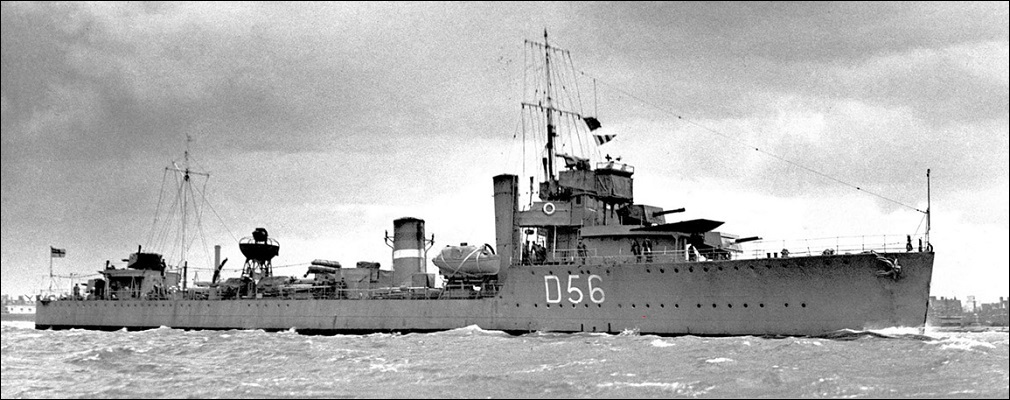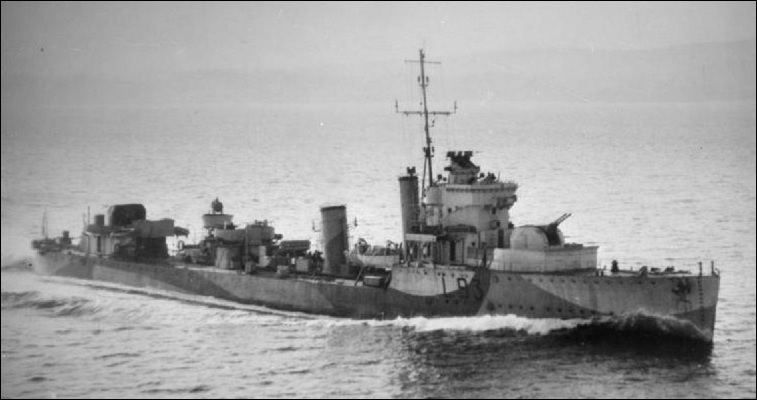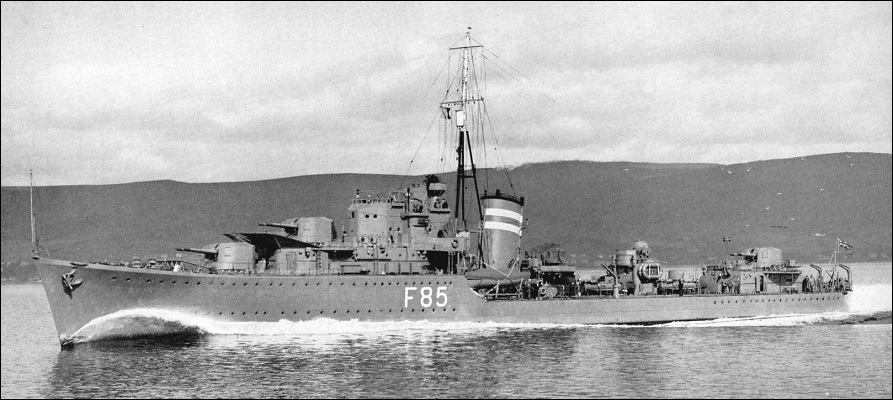● ● ●
NOTE ON NOMENCLATURE
The following terms and abbreviations are used in
this article: AA (antiaircraft guns), A/S (antisubmarine), DC
(depth charge), DP (dual-purpose guns and fire control
systems capable of engaging both surface and air targets),
HA (high-angle antiaircraft gun), HMS (His Majesty's Ship),
MG (machine gun), RAN (Royal Australian Navy), RCN (Royal
Canadian Navy) RN (Royal Navy), TT (torpedo
tubes), USN (United States Navy). Some British guns were
identified by the weight of the shell they fired, e.g. the
12-pounder (3in) HA gun. It was so designated to distinguish
it from the 3in HA gun, which was similar but of different
design.
● ● ●
In the years immediately following
World War I, the Royal Navy’s large destroyer force was
quickly reduced. All such ships built prewar and most of
those built early in the war were discarded beginning in
1919 and by 1922 the only ones remaining in service were
those built from 1916 onward. In 1926-30 there was a second
round of scrapping, this time because newly built destroyers
were beginning to join the fleet. Older destroyers continued
to be discarded in the 1930s until by 1939 there were only
about 70 Great War veterans left, a number that included
some flotilla leaders, essentially large destroyers with
facilities for a flotilla commander and his staff.
Most of the surviving veterans
belonged to the “V & W” class—which actually consisted of
five sub-classes. These ships are of particular interest in
that they set the pattern for most of the destroyers built
for the RN between 1926 and 1939. Their design was based on
that of the five “V” class flotilla leaders that entered
service in 1917. Intelligence reports (later found to be
erroneous) led the Admiralty to believe that the German Navy
was building a new class of large destroyers, so it was
decided to adapt the design of the “V” class flotilla
leaders for the RN’s next destroyer class. The initial batch
of 23, known as the Admiralty “V” sub-class, were 312 feet
in length, displaced 1,207 tons and had a maximum speed of
34 knots. Armament consisted of 4 x 4in guns (two forward,
two aft), 1 x 3in HA gun and 4 x TT (two twin mounts). Nine of
the class were fitted with mine rails and could be converted
for minelaying with one 4in gun and all TT removed to free
space for up to 60 mines.

HMS Wolfhound in 1936. She was a "V & W" class
destroyer of the Admiralty "W" sub-class, built in 1917.
Wolfhound was almost 20 years old when this photo was taken
and still in her original configuration. Early in World War II
she was converted into an an AA escort.
(Imperial
War Museum)
The following four sub-classes were
very similar to the Admiralty “Vs,” except that triple TT
mounts replaced the twins and 4.7in guns replaced the 4in in
the nine ships of the last two sub-classes. The triple TT
eventually replaced one or both of the twin TT in the
earlier ships. In a few ships 2 x 2-pounder pom-pom AA in
single mounts replaced the 3in HA. Including the flotilla
leaders, 67 “V & Ws” were built, while 40 either under
construction or on order at the end of the war were
canceled. Four went to the Royal Australian Navy (RAN),
gaining fame in World War II as the “Scrap Iron Flotilla.”
At the time they entered service
the “V & Ws” were the world’s most advanced destroyers.
Being available in large numbers they more than met the
needs of the peacetime fleet, so that no further destroyers
were built up to 1925. Six were scrapped in the 1930s,
leaving 57 at the beginning of World War II. Most served
initially as fleet destroyers but as more modern ships
entered service, many of the “V & Ws” underwent conversion
for escort work.
In 1938-41 fourteen of them were
converted into AA escorts. The bridge was remodeled, all TT
were removed and the gun armament was changed to 4 x 4in HA
in two twin mounts controlled by a DP director, plus either
8 x caliber .50 AA MG (two quadruple mounts) or 2 x
2-pounder (40mm) AA pom-pom (single mounts). In 1941-42, the
MG and pom-poms were replaced by 4 x 20mm Oerlikon AA
(single mounts). Fire control radar and air warning radar
were added when they became available. The Wairs, as they
were called, also had 2 x DC racks and 2 x DC throwers.
Normally they carried 45 DC.

HMS Verdun of
the Admiralty "V" sub-class as converted to an AA
escort. Note the remodeled bridge, surmounted by a
DP fire control director. Her original 4 x 4in guns
(single mounts) have been replaced by 4 x 4in HA in
two twin mounts. (V & W Destroyer Association)
In 1941-43, 21 “V & Ws” were
converted into long-range escorts. One boiler and funnel
were deleted to make room for extra fuel and accommodation,
cutting their speed to 24-25 knots—considered adequate for
the escort role. All TT were removed and the gun armament
was reduced to 2 x 4in or 4.7in, 1 x 12-pounder HA and 4 x
20mm AA (single mounts). They also received a Hedgehog A/S
mortar, two DC racks and four DC throwers. Normally they
carried 110 DC. A further twelve became short-range escorts,
mainly because they had a different arrangement of boiler
rooms that rendered them unsuitable for the long-range
escort conversion. The gun armament was reduced to 2 x 4.7in
to clear space for a Hedgehog forward and DC racks and
throwers aft. One of the triple TT mounts was removed and
replaced by a 12-pounder HA. Light AA was variable, some
ships having 2 x 2-pounder pom-pom and 2 or 3 x 20mm, others
having 4 x 20mm (all single mounts). Several also received
an Army-pattern twin 6-pounder gun forward for defense
against German E-boats. Between 20 and 70 DC were carried.
By 1943 all the “V & Ws” except for
five lost early in the war had undergone conversion and like
their American cousins, the famous
flush-deckers, they served
with distinction despite their age.
When destroyer production for the
RN resumed in 1925 the first ships built were larger but
otherwise quite similar to the “V & Ws,” with the same
general layout and armament. HMS Amazon and HMS
Ambuscade, prototype destroyers built by Thornycroft and
Yarrow respectively in 1925-26, carried 4 x 4.7in guns, 2 x
2-pounder pom-pom (single mounts) as light AA and 6 x TT
(two triple mounts). They were followed by the eighteen
ships of the “A” and “B” classes, built in 1928-31, two of
which went to the Royal Canadian Navy (RCN), as did three of
the following “C” class. They had the same gun armament as
the two prototype destroyers but carried 8 x TT (two
quadruple mounts).

HMS Basilisk of
the "B" class in 1937. Note her general configuration,
very similar to the "V & W" class destroyers.
Basilisk was bombed and sunk on 1 June 1940 during
the Dunkirk evacuation. Before her loss, she carried
some 700 British soldiers to safety. (Imperial War
Museum)
The following six classes proceeded
through the alphabet to “G” with minor improvements. With
the “I” class, built in 1936-37 the torpedo armament was
increased to 10 x TT (two quintuple mounts). These, however,
proved to be too heavy and were replaced by quadruple
mounts. Two ships of the “E” class and all eight of “I”
class were built with mine rails and could be converted for
minelaying by removing two 4.7in guns and all TT to free
space for 60 mines. Six new flotilla leaders were also built
between 1929 and 1936. They were enlarged editions of the
destroyers building at the same time, and carried a fifth
4.7in gun amidships. Counting the flotilla leaders, 73 new
destroyers were built for the RN between 1925 and 1936. At
the same time, however, even larger numbers of old
destroyers were discarded.
Many of the “A” through “I” ships
were converted into escorts during the war, with armament
similar to the “V & W” long-range escort conversion: 2 or 3
x 4.7in, 4 x 20mm (single mounts) as light AA, 4 x TT
(quadruple mount), Hedgehog, 2 x DC racks and 4 x DC
throwers. Generally they carried 100-125 DC.

HMS Fame
of the "F" class in 1942, after conversion into
an escort destroyer. She survived the war and
was sold to the Dominican Republic in 1949,
serving as the Generalissimo until 1968.
(Imperial War Museum)
As built, these interwar destroyers
had one glaring weak spot: totally inadequate AA armament.
When the USN resumed building destroyers in 1933-34, they
were armed with director-controlled 5in DP guns effective
against both surface and air targets—a choice that paid off
handsomely during the war. But the main armament of the RN
destroyers, the 4.7in gun, could be elevated only 30 degrees
from the horizontal. This was sufficient to engage surface
targets at the gun’s maximum range but quite insufficient to
engage air targets. During the war it was found necessary to
delete one TT mount and replace it with a 12-pounder or 3in
HA gun. As for light AA, the single 2-pounder pom-pom was
but marginally effective and the quadruple caliber .50 MG
was almost useless. During the war they were replaced as
soon as possible by four to six 20mm guns, usually in single
mounts.
Only with the “Tribal” class, built
in 1936-38, was there a major departure from the standard
design described above. These ships, built as a reply to the
latest heavily armed destroyers of the Japanese Navy,
displaced over 1900 tons, versus around 1400 for the
preceding “I” class. Though they carried only one quadruple
TT mount, the gun armament was doubled: 8 x 4.7in in four
twin mounts with 40 degree elevation—still not enough for
effective AA defense. During the war, therefore, one 4.7in
mount was replaced by a twin 4in HA mount in some ships. The
light AA armament was somewhat improved: 4 x 2-pounder
pom-pom in a quadruple mount, and during the war 2 x 40mm
Bofors and 8 to 10 x 20mm AA (all single mounts) were added.
The “Tribals” could carry up to 40 DC. Sixteen were built
for the RN, three in Australia for the RAN, and eight for
the RCN, four in Britain and four in Canada.

HMS
Mashona of the "Tribal" class, circa
1938. She was badly damaged by German
bombers in May 1941 during the pursuit and
sinking of the battleship Bismarck
and had to be scuttled. (Imperial War
Museum)
The ships of the “J” and “K”
classes were the last destroyers built before the outbreak
of World War II, and they set the pattern for the so-called
War Emergency classes. Though smaller than the “Tribals”
they were larger than earlier classes, displacing just over
1700 tons. Armament was 6 x 4.7in (three twin mounts of the
“Tribal” type), 4 x 2-pounder pom-pom (quadruple mount) and
10 x TT (two quintuple mounts). A single 4in HA gun could be
carried in place of one TT mount. Later 2 to 4 x 40mm and 8
to 10 x 20mm AA (all single mounts) were added.
Neither the “Tribal” class nor the
“J” and “K” classes had corresponding specially built
flotilla leaders; they were large enough that the standard
destroyer could be fitted as a leader, mainly by providing
extra accommodation. One ship of each class was modified in
this manner, a practice that was continued with the War
Emergency classes.

HMS Jupiter
of the "J" class running acceptance trials in
June 1939. Her quadruple 2-pounder pom-poms,
mounted just aft of the funnel, are covered with
a tarpaulin. Jupiter was lost on a mine
during the Battle of the Java Sea, 27 February
1942. A month and a half earlier, she herself
had sunk the Japanese submarine I-60.
(Imperial War Museum)
During the war, losses among all of
the above classes were very heavy. Of the eighteen “As” and
“Bs,” for example, eleven were sunk: one by a German
cruiser, one torpedoed by an aircraft, six by bombs, two by
mines, and one so badly damaged by bombs that she was never
repaired. It was the same story with the “Tribal” class. Of
the sixteen RN ships, ten were sunk: one torpedoed by an
Italian destroyer, three torpedoed by U-boats, one torpedoed
by an aircraft, one sunk by coastal artillery and four by
bombs. Losses were heaviest between 1939 and 1943 and thus
were concentrated among the older classes. The full roster
pays somber tribute to the fighting spirit of the Royal Navy
and the high price of its eventual victory.
● ● ●